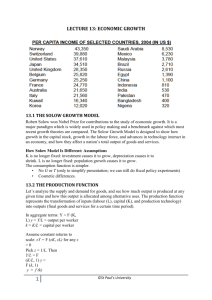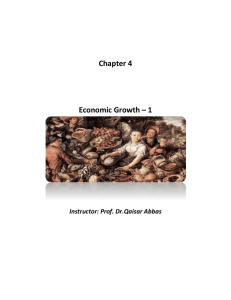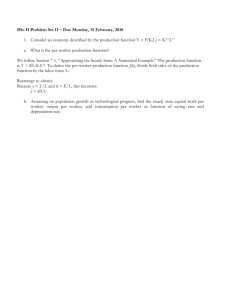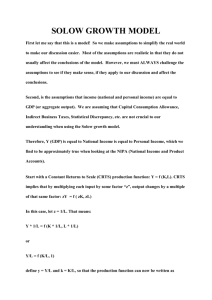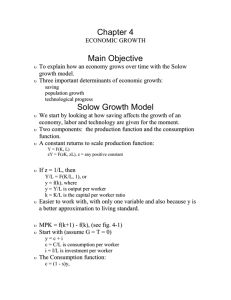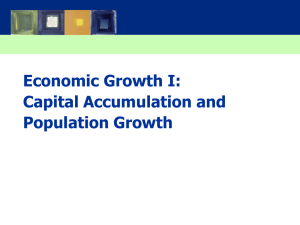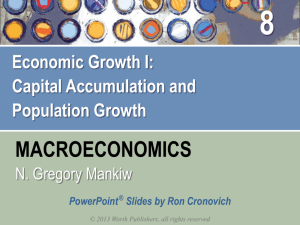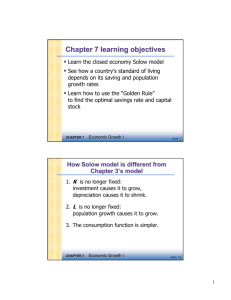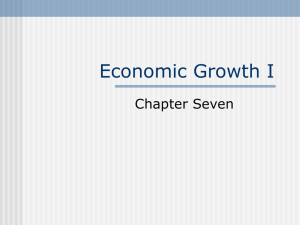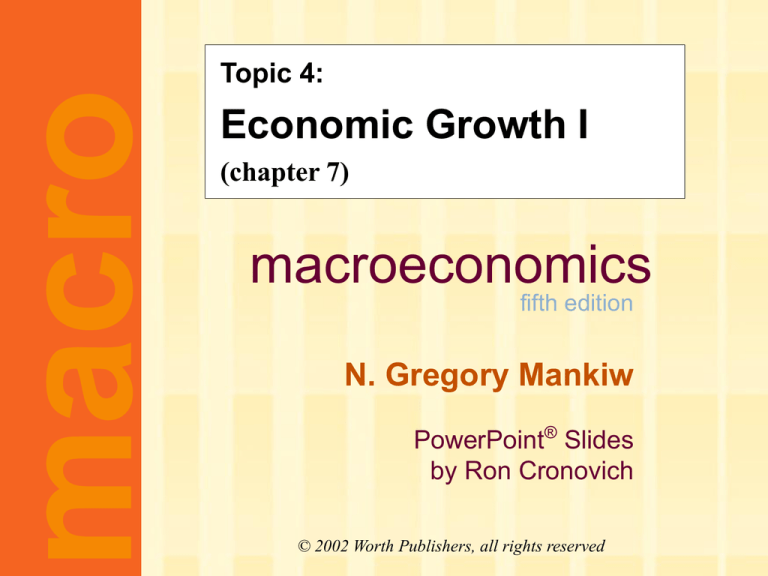
macro
Topic
4:
CHAPTER
SEVEN
Economic
EconomicGrowth
GrowthI(ch.
I 7)
(chapter 7)
macroeconomics
fifth edition
N. Gregory Mankiw
PowerPoint® Slides
by Ron Cronovich
© 2002 Worth Publishers, all rights reserved
Chapter 7 learning objectives
Learn the closed economy Solow model
See how a country’s standard of living
depends on its saving and population
growth rates
Learn how to use the “Golden Rule”
to find the optimal savings rate and capital
stock
CHAPTER 7
Economic Growth I
slide 1
selected poverty statistics
In the poorest one-fifth of all countries,
daily caloric intake is 1/3 lower
than in the richest fifth
the infant mortality rate is
200 per 1000 births, compared to
4 per 1000 births in the richest fifth.
…
CHAPTER 7
Economic Growth I
slide 2
Income and poverty in the world
selected countries, 2000
100
Madagascar
% of population
living on $2 per day or less
90
India
Nepal
Bangladesh
80
70
60
Botswana
Kenya
50
China
40
Peru
30
Mexico
Thailand
20
Brazil
10
0
$0
Chile
Russian
Federation
$5,000
$10,000
S. Korea
$15,000
$20,000
Income per capita in dollars
CHAPTER 7
Economic Growth I
slide 3
Huge effects from tiny differences
In rich countries like the U.S.,
if government policies or “shocks”
have even a small impact on the
long-run growth rate,
they will have a huge impact
on our standard of living
in the long run…
CHAPTER 7
Economic Growth I
slide 4
Huge effects from tiny differences
annual
growth rate
of income
per capita
…25 years
…50 years
…100 years
2.0%
64.0%
169.2%
624.5%
2.5%
85.4%
243.7%
1,081.4%
CHAPTER 7
percentage increase in
standard of living after…
Economic Growth I
slide 5
Huge effects from tiny differences
If the annual growth rate of
U.S. real GDP per capita
had been just
one-tenth of one percent higher
during the 1990s,
the U.S. would have generated
an additional $449 billion of income
during that decade
CHAPTER 7
Economic Growth I
slide 6
The lessons of growth theory
…can make a positive difference in the
lives of hundreds of millions of people.
These lessons help us
understand why poor
countries are poor
design policies that
can help them grow
learn how our own
growth rate is affected
by shocks and our
government’s policies
CHAPTER 7
Economic Growth I
slide 7
The Solow Model
due to Robert Solow,
won Nobel Prize for contributions to
the study of economic growth
a major paradigm:
– widely used in policy making
– benchmark against which most
recent growth theories are compared
looks at the determinants of economic
growth and the standard of living in the
long run
CHAPTER 7
Economic Growth I
slide 8
How Solow model is different from
Chapter 3’s model
1. _______________________
investment causes it to grow,
depreciation causes it to shrink.
2. _________________________
population growth causes it to grow.
3. The consumption function is simpler.
CHAPTER 7
Economic Growth I
slide 9
How Solow model is different from
Chapter 3’s model
4. No G or T
(only to simplify presentation;
we can still do fiscal policy experiments)
5. Cosmetic differences.
CHAPTER 7
Economic Growth I
slide 10
The production function
In aggregate terms: Y = F (K, L )
Define: y = _______________
k = _______________
Assume ____________________:
zY = F (zK, zL ) for any z > 0
Pick z = 1/L. Then
Y/L = F (K/L , 1)
y = F (k, 1)
y = f(k)
where f(k) = F (k, 1)
CHAPTER 7
Economic Growth I
slide 11
The production function
Output per
worker, y
f(k)
1
MPK =_________
Note: this production function
exhibits ________ MPK.
Capital per
worker, k
CHAPTER 7
Economic Growth I
slide 12
The national income identity
Y=C+I
(remember, no G )
In “per worker” terms:
_________
where c = ____ and i = ____
CHAPTER 7
Economic Growth I
slide 13
The consumption function
s = the saving rate,
________________________
(s is an exogenous parameter)
Note: s is the only lowercase variable
that is not equal to
its uppercase version divided by L
Consumption function: __________
(per worker)
CHAPTER 7
Economic Growth I
slide 14
Saving and investment
saving (per worker) = y – c
= ________
=
_____
National income identity is y = c + i
Rearrange to get: __________
(investment = saving, like in chap. 3!)
Using the results above,
_____________
CHAPTER 7
Economic Growth I
slide 15
Output, consumption, and investment
Output per
worker, y
___
__
___
__
__
k1
CHAPTER 7
Economic Growth I
Capital per
worker, k
slide 16
Depreciation
Depreciation
per worker, k
= the rate of depreciation
=_________________________
k
1
_
Capital per
worker, k
CHAPTER 7
Economic Growth I
slide 17
Capital accumulation
The basic idea:
Investment makes
the capital stock bigger,
depreciation makes it smaller.
CHAPTER 7
Economic Growth I
slide 18
Capital accumulation
Change in capital stock = investment – depreciation
k
=
__
–
__k
Since i = sf(k) , this becomes:
k = __________
CHAPTER 7
Economic Growth I
slide 19
The equation of motion for k
k = s f(k) – k
the Solow model’s central equation
Determines behavior of capital over time…
…which, in turn, determines behavior of
all of the other endogenous variables
because they all depend on k.
E.g.,
income per person: y =________
consump. per person: c =_______
CHAPTER 7
Economic Growth I
slide 20
The steady state
k = s f(k) – k
If investment is just enough to cover depreciation
[sf(k) = k ],
then capital per worker will remain constant:
___________.
This constant value, denoted k*, is called the
_______________________.
CHAPTER 7
Economic Growth I
slide 21
Moving toward the steady state
Investment
and
depreciation
k = sf(k) k
k
sf(k)
k k*
CHAPTER 7
Economic Growth I
Capital per
worker, k
slide 22
A numerical example
Production function (aggregate):
Y F (K , L) K L K
L
1/ 2 1/ 2
To derive the per-worker production function,
divide through by L:
Y
_________________
L
Then substitute y = Y/L and k = K/L to get
y f (k ) ____
CHAPTER 7
Economic Growth I
slide 23
A numerical example, cont.
Assume:
s = 0.3
= 0.1
initial value of k = 4.0
CHAPTER 7
Economic Growth I
slide 24
Approaching the Steady State:
A Numerical Example
Year
k
y
c
i
k
1
4.000
2.000
1.400
0.600
0.400
0.200
2
4.200
2.049
1.435
0.615
0.420
0.195
3
4.395
2.096
1.467
0.629
0.440
0.189
4
…
10
…
25
…
100
…
4.584
2.141
1.499
0.642
0.458
0.184
5.602
2.367
1.657
0.710
0.560
0.150
7.351
2.706
1.894
0.812
0.732
0.080
8.962
2.994
2.096
0.898
0.896
0.002
9.000
3.000
2.100
0.900
0.900
0.000
CHAPTER 7
Economic Growth I
k
slide 25
Exercise: solve for the steady state
Continue to assume
s = 0.3, = 0.1, and y = k 1/2
Use the equation of motion
k = s f(k) k
to solve for the steady-state values of
k, y, and c.
CHAPTER 7
Economic Growth I
slide 26
Solution to exercise:
k 0
def. of steady state
s f (k *) k *
eq'n of motion with k 0
______________________________
______________________________
Solve to get: k * 9 and y * _________
Finally, c * (1 s )y * 0.7 3 2.1
CHAPTER 7
Economic Growth I
slide 27
An increase in the saving rate
An increase in the saving rate raises investment…
…causing the capital stock to grow toward a new steady state:
Investment
and
depreciation
k
k
CHAPTER 7
Economic Growth I
*
1
k
*
2
k
slide 28
Prediction:
Higher s ______.
And since y = f(k) ,
higher k* ______ .
Thus, the Solow model predicts that countries
with higher rates of saving and investment
will have higher levels of capital and income
per worker in the long run.
CHAPTER 7
Economic Growth I
slide 29
International Evidence on Investment
Rates and Income per Person
Incom e pe r
person in 1992
(logar ithm ic sc ale)
1 00 ,00 0
Canada
Denmark
U.S.
1 0,0 00
Mexi co
E gypt
P aki stan
Iv ory
Coast
Japan
F inland
B razi l
U.K.
Israe l
F ranceIt aly
Si ngapore
P eru
Indonesia
1 ,00 0
Zi mbabwe
Keny a
India
Chad
1 00
Germany
0
Uganda
5
Came roon
10
15
20
25
30
35
40
Inve stm ent a s pe rce ntage of output
(a ve ra ge 1960–1992)
CHAPTER 7
Economic Growth I
slide 30
The Golden Rule: introduction
Different values of s lead to different steady states.
How do we know which is the “best” steady state?
Economic well-being depends on consumption,
so the “best” steady state has the highest possible
value of consumption per person: c* = (1–s) f(k*)
An increase in s :
• ______________________________________
• ______________________________________
So, how do we find the s and k* that maximize c* ?
CHAPTER 7
Economic Growth I
slide 31
The Golden Rule Capital Stock
*
k gold
the Golden Rule level of capital,
__________________________
___________________________.
To find it, first express c* in terms of k*:
c*
=
y*
i*
= f (k*) i*
= f (k*) k*
CHAPTER 7
Economic Growth I
slide 32
The Golden Rule Capital Stock
steady state
output and
depreciation
Then, graph
f(k*) and k*,
and look for the
point where the
gap between
them is biggest.
k*
f(k*)
____
____________
__________
CHAPTER 7
*
k gold
Economic Growth I
steady-state
capital per
worker, k*
slide 33
The Golden Rule Capital Stock
c* = f(k*) k*
is biggest where
_______________
_______________
_______________
_____________:
k*
f(k*)
*
c gold
___=___
*
k gold
CHAPTER 7
Economic Growth I
steady-state
capital per
worker, k*
slide 34
Use calculus to find golden rule
We want to maximize: c* = f(k*) k*
From calculus, at the maximum we know the
derivative equals zero.
Find derivative: dc*/dk*= MPK
Set equal to zero: MPK = 0 or MPK =
CHAPTER 7
Economic Growth I
slide 35
The transition to the
Golden Rule Steady State
The economy does NOT have a tendency to
move toward the Golden Rule steady state.
Achieving the Golden Rule requires that
policymakers adjust s.
This adjustment leads to a new steady state
with higher consumption.
But what happens to consumption
during the transition to the Golden Rule?
CHAPTER 7
Economic Growth I
slide 36
Starting with too much capital
*
If k * k gold
then increasing
c* requires a
__________.
y
In the transition
to the
Golden Rule,
consumption is
_______ at all
points in time.
c
CHAPTER 7
i
t0
Economic Growth I
time
slide 37
Starting with too little capital
*
If k * k gold
then increasing c*
requires an
_______.
y
Future generations c
enjoy higher
consumption,
but the current one
i
experiences
________________
__________.
CHAPTER 7
t0
Economic Growth I
time
slide 38
Population Growth
Assume that the population--and labor force-grow at rate n. (n is exogenous)
L
L
n
EX: Suppose L = 1000 in year 1 and the
population is growing at 2%/year (n = 0.02).
Then L = n L = 0.02 1000 = 20,
so L = 1020 in year 2.
CHAPTER 7
Economic Growth I
slide 39
Break-even investment
( + n)k = break-even investment,
__________________________________
_____________________.
Break-even investment includes:
___ to replace capital as it wears out
___ to equip new workers with capital
(otherwise, k would fall as the existing
capital stock would be spread more thinly
over a larger population of workers)
CHAPTER 7
Economic Growth I
slide 40
The equation of motion for k
With population growth, the equation of
motion for k is
k = ____ _______
actual
investment
CHAPTER 7
Economic Growth I
break-even
investment
slide 41
The impact of population growth
Investment,
break-even
investment
An increase in n
causes an ______
in break-even
investment,
leading to a
_______________
_________.
Capital per
worker, k
CHAPTER 7
Economic Growth I
slide 42
Prediction:
Higher n _________.
And since y = f(k) ,
lower k* _________ .
Thus, the Solow model predicts that
countries with higher population growth
rates will have lower levels of capital and
income per worker in the long run.
CHAPTER 7
Economic Growth I
slide 43
Incom e pe r
person in 1992
(logar ithm ic sc ale)
International Evidence on Population
Growth and Income per Person
100,000
Germany
Denmark
U.S.
Canada
Israe l
10,000
U.K.
It aly
F inland
Japan
F rance
Mexi co
Si ngapore
E gypt
B razi l
P aki stan
P eru
Indonesia
1,000
Iv ory
Coast
Came roon
Keny a
India
Zi mbabwe
Chad
100
0
CHAPTER 7
1
2
Economic Growth I
Uganda
3
4
P opulation growth ( pe rc ent per y ea r)
(a ve ra ge 1960–1992)
slide 44
The Golden Rule with Population Growth
To find the Golden Rule capital stock,
we again express c* in terms of k*:
c* =
y*
i*
= f (k* ) _________
c* is maximized when
MPK = + n
or equivalently,
___________
CHAPTER 7
Economic Growth I
In the Golden
Rule Steady State,
the marginal product of
capital
__________________
________ equals the
population growth rate.
slide 45
Chapter Summary
1. The Solow growth model shows that, in the
long run, a country’s standard of living depends
positively on its saving rate.
negatively on its population growth rate.
2. An increase in the saving rate leads to
higher output in the long run
faster growth temporarily
but not faster steady state growth.
CHAPTER 7
Economic Growth I
slide 46
Chapter Summary
3. If the economy has more capital than the
Golden Rule level, then reducing saving will
increase consumption at all points in time,
making all generations better off.
If the economy has less capital than the
Golden Rule level, then increasing saving will
increase consumption for future generations,
but reduce consumption for the present
generation.
CHAPTER 7
Economic Growth I
slide 47

